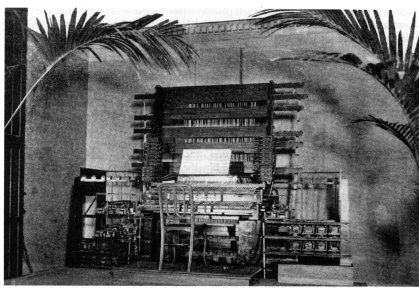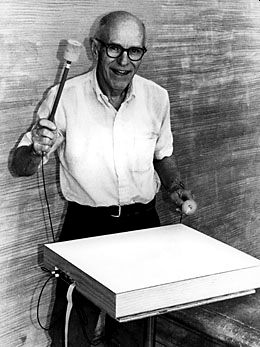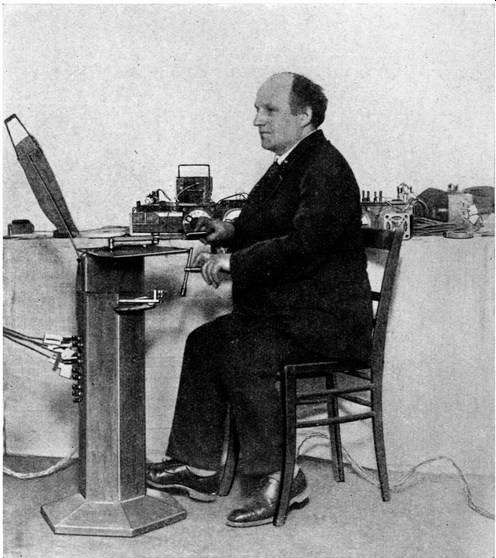As technology continued to advance, people started to create sound through electronic means in the latter part of the 18th century and signalled the birth of the electrophones. As a new musical instrument class, electrophones deviated from the traditional way of producing music and evolved to have its distinct sound. Here are some of the most notable electrophones that played a huge part in the development of the music we hear today.
Croix Sonore
The Croix Sonore is an early electronic musical instrument that is considered as a cousin of the theremin. Like the latter, the instrument’s pitch varies depending on the proximity and movement of the player’s arms to the antenna. The significant differences of Croix Sonore are its cross-like antenna and its circuitry that is mounted inside a sphere.
Russian composer Nikolai Obukhow conceived the Croix Sonore in 1918, and its prototype model was built by Pierre Dauvillier and Michel Billaudot in 1924. Then, an improved version was developed for demonstration in 1934. The instrument is said to be designed as a ritualistic element in a Gesamtkunstwerk or a work that involves using all art forms.
Hammond Organ
The Hammond organ is one of the most renowned and most important of the electronic organs. It was named after its American inventor Lauren Hammond, who patented the instrument in 1934. Brimming with sophistication, the Hammon organ features two keyboards and a pedal set operated by the feet. It produces sound by generating electric currents from a revolving metal, motor-driven tonewheels. Then, give variety to the sound using its harmonic control. At a certain extent, the sound created resembles other instruments, such as the flute, oboe, and the violin.
Chamberlin
The Chamberlin keyboard is the brainchild of Harry Chamberlin. Based on the stories, the Wisconsin inventor conceived the idea of creating the instrument as he was recording himself playing the organ. Chamberlain deemed that if he could play back the sound of an organ, he can do that to other instruments as well.
With that, the Chamberlin keyboard was born. Each of its keys corresponds to a tape with pre-recorded sounds. As a player pushes a key, it triggers the tape-playing mechanism and plays the assigned note. Some of the tracks included in the Chamberlin were the flute, organ, cello, violin, trumpet, and the organ.
Mellotron
The Mellotron is an electromechanical instrument developed in 1963. Like the Chamberlin, the instrument used a tape-playing mechanism, in which the keys serve as a trigger to play sound recordings. It mass-produced better and was developed for home use, containing varied sounds and accompaniments. Later on, many pop and rock groups saw the Mellotron’s potential and used them in their songs and performances. “The Beatles” is one of the most notable groups who used the Mellotron, as heard on their hit track “Strawberry Fields Forever”.
Ondes Martenot
Invented in France in 1928, the Ondes Martenot is an early monophonic electrophone developed by Maurice Martenot. It is composed of two units, the pull-wire with a ribbon controller, and the keyboard. As the player slides the ribbon controller along the pull-wire, it produces “wavering” sounds, resembling that of a theremin. It has been used by many composers, such as Schmitt, Ibert, but was popularized by Messiaen. Meanwhile, the instrument also worked its magic on television and movie soundtracks, such as in horror and science fiction series and flicks.
Telharmonium
The Telharmonium, or the Dynamophone, is one of the earliest electrophones. It was developed by Thaddeus Cahill in 1896, patented in 1897, and was first introduced in 1906. As an electromechanical instrument, it made use of rotary electromagnetic tonewheels to generate electrical impulses, which were then transmitted through telephone network wires and heard through horn speakers. It was soon displaced by more efficient and practical electronic musical instruments.
Novachord
Designed by C. N. Williams, John M. Hanert, and Laurens Hammond, the Novachord is often deemed to be the first commercial polyphonic synthesizer. It is a massive entirely tube-based and all-electronic synthesizer that integrates many control and circuit elements, such as filters, VCAS, oscillators, frequency dividers, and filters. From 1939 to 1942, the Hammond company produced more than a thousand Novachords. The instrument made exquisite, spectral sounds, which was used in movie and television soundtracks, such as in “The Twilight Zone,” “House of Frankenstein,” and “Gone with the Wind.”
Clavioline
The Clavioline is an electronic and monophonic keyboard instrument invented by Constant Martin in Versailles, France in 1947, and considered to be the predecessor of the synthesizer. It featured a 3-octave keyboard, with a control panel and sound generator to change the sound’s timbre, which is then connected to a tube amplifier or speaker unit. While the purpose of the Clavioline was to be an accompanying instrument, the ability to make combinations with the instrument enticed many musicians. With that, it soon found its way to pop music in the 1960s. Several models were produced under different licensed manufacturers, such as the Reverb, Standard, and the Concert.
Radiodrum
The Radiodrum, or the radio-baton, is a capacitive sensing electronic musical instrument developed and patented by the Bell Labs in the 1980s. The instrument features a three-dimension controller acting up like a drum. It identifies the gestures of the two drumsticks to control sound-production, with each movement being transmitted as signals. These signals are then used to alter different music variables such as volume and pitch, or trigger pre-recorded notes of segments of music.
Trautonium
Another early electronic musical instrument is the Trautonium, which was invented by Friedrich Trautwein in Berlin in 1930. It generates tones through an oscillation radio tube, which then creates electronic pulses heard through a speaker. Through resonant filters and subtractive synthesis, the tone is altered through the use of push buttons, allowing varied timbres or colors. With that, the sound produced was unusual and unique compared to other instruments during its era.
Spharophon
The Spharohon is another product brought by the creative minds of electrical engineers from the early part of the 20th century. It was first developed by Jorg Mager in 1921 and named it as “Electrophon”, but changed its name to Spharophon in its exhibition in 1926 in Germany. Mager created two distinct types of the instrument. The first version resembled the Theremin, which can alter the sound’s timbre and pitch. The latter version came to be a keyboard-based instrument that can generate quarter notes from an octave using a radio-frequency oscillator.
With the emergence of the electrophones, new ways on how people produce and create sound surfaced, changing the way how people hear music. Adding the musician’s limitless creativity and the world’s continued advancement, we can expect more dynamic changes in the world of music.




